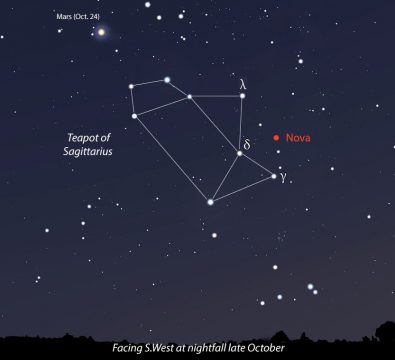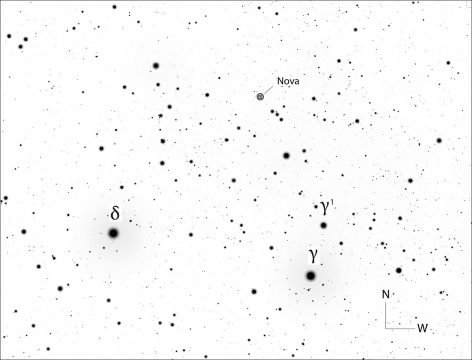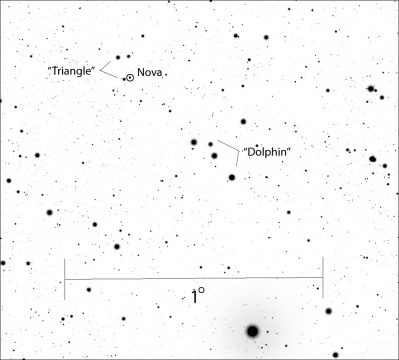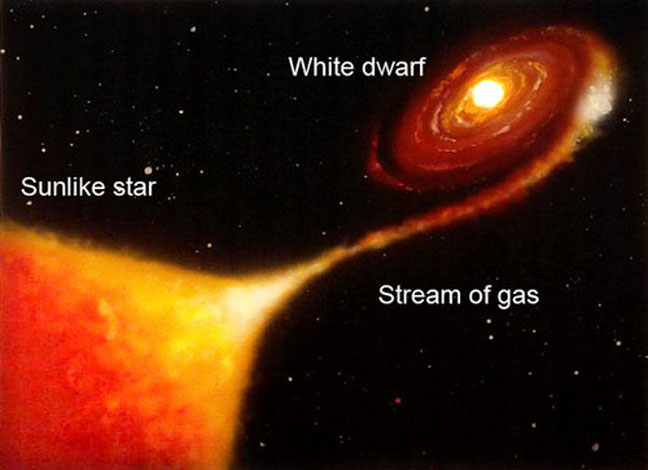A nova in Sagittarius, discovered a few nights ago by a Japanese amateur, has become bright enough to see in binoculars.
| Update: As of October 31st, the nova had been holding at about magnitude 8.0 for a week. It's temporarily designated TCP J18102829-2729590.
This is not to be confused with another nova just above the spout of the Sagittarius Teapot! The new one, temporarily named ASASSN-16ma, was discovered five days later on October 25th. As of October 31st it was about magnitude 9.7 and perhaps still rising. Expect an article by Bob King shortly. |

Stellarium
Just in the nick for time — at least for northern observers — a bright nova has been discovered in Sagittarius. I say "nick of time" because the constellation is sinking in the southwestern sky right after dusk, affording only a short viewing window from mid-northern latitudes. But a window it is, and there's still time to snatch a view of this amazing stellar explosion. Just make sure to look right after the end of twilight. That means about an hour and a half after your local sunset time.

Stellarium
Well-known nova hunter Koichi Itagaki of Japan nabbed the "new star" on October 20th, using a 180-mm telephoto lens to take sky-patrol photos. At the time it was only about 11th magnitude. But within two days, the star shot up an additional three magnitudes and now shines brighter than 8.0. That puts it within range of 50-mm binoculars and any telescope you might have.

Stellarium
Get out early for the best views. First, locate Sagittarius in the southwestern sky using Mars as your guide. Then focus on the two stars at the end of the spout and use the maps above to track your way through a dense Milky Way field to pinpoint the nova. Work step by step; it may take some time. It is Sagittarius after all, a constellation known for its stellar throngs.

NASA
All classical novae are close binary stars with a compact white dwarf stealing hydrogen from its companion. The gas ultimately funnels down to the surface of the dwarf, where its piles up on the star’s surface. It becomes compacted by gravity and heated until hydrogen fusion ignites. The layer explodes like a hydrogen bomb in the shape a thin shell enclosing the star. This is what you see when you look at a nova – a gigantic bomb going off! The underlying white dwarf survives intact, and begins accreting a new, fresh layer that will eventually explode again.
Material gets blasted into space at tremendous speeds of some 3,000 kilometers per second (6.2 million mph). A faint, unnoticed star brightens 50,000 to 100,000 times in a matter of hours, becoming luminous enough for someone back here on Earth to spot it in binoculars over the trees. Simply remarkable.
You can keep track of what the nova's doing night to night by visiting the American Association of Variable Star Observers (AAVSO) website and entering its temporary name, TCP J18102829-2729590, in the Pick a Star box. You then have options to check recent observations, plot a light curve of them, or create a chart of your own. More details, including recent magnitude estimates, can be found in the AAVSO's Alert Notice for the nova. Click here to download an AAVSO chart with magnitudes, so you can track the star's changing brightness.
Good luck and let us know how the nova's doing! I can't wait to see it myself tonight.
 28
28









Comments
Graham-Wolf
October 24, 2016 at 8:28 pm
Thanks Bob.
Heard about it just yesterday.
It's definitely observable here at 46 South, NZ, and not too far from Comet 29p/SW1.
Suggesting that 29p/SW1 comet observers, also swing their scopes etc, across to the Nova and "clock it", too. Two visual trophies for the price of one...
You should have NO trouble picking it out, Bob. Good luck!
Regards
Graham W. Wolf:- NZ
You must be logged in to post a comment.
Joe Stieber
October 24, 2016 at 10:33 pm
Thanks for the heads-up Bob! I was out earlier this evening (24-Oct-2016) and easily spotted the nova with my 16x70 binoculars from a suburban location. I even got a snapshot of it with my DSLR.
You must be logged in to post a comment.
Bob KingPost Author
October 24, 2016 at 10:36 pm
Great to hear it, Joe. I managed to get out just in time here tonight and also caught the nova. Through the scope it appeared red. Using an AAVSO chart, I estimated magnitude +7.9. Brightest nova in a while.
You must be logged in to post a comment.
SNH
October 25, 2016 at 4:42 pm
Sweet! Another Sagittarius nova!! I wish I would have caught your article last evening though when I was out observing. That's okay because I can set up again today or observe the nova in binoculars. Awesome! I look binoculars objects. Keep me posted.
You must be logged in to post a comment.
Bob KingPost Author
October 25, 2016 at 4:44 pm
Wishing you clear skies, SNH! I saw it at +7.9. A tough one for me in binoculars (it was low, I live north) but simple in my scope.
You must be logged in to post a comment.
October 27, 2016 at 4:15 am
Very tasty. Well done, Itagaki, and thanks for the article, Bob!
You must be logged in to post a comment.
Bob KingPost Author
October 27, 2016 at 11:08 am
Thanks Steakandeggs -- I hope you're able to see it yourself before too long.
You must be logged in to post a comment.
October 28, 2016 at 11:43 am
How long will the nova last?
You must be logged in to post a comment.
ScienceKid
October 28, 2016 at 4:38 pm
I hope for a while.
You must be logged in to post a comment.
Bob KingPost Author
October 28, 2016 at 5:05 pm
Science Kid,
You can ready my response to DirtyLens. Also keep this in mind: the nova will return to the morning sky eventually and be visible for a long time though of course it will probably have faded a good amount.
You must be logged in to post a comment.
Bob KingPost Author
October 28, 2016 at 5:04 pm
Dirty Lens,
That depends on your where you live, your latitude. If you live in the southern U.S., you'll be able to view it for another 4 weeks or so. If in the northern U.S., about two weeks.
You must be logged in to post a comment.
Dave Mitsky
October 28, 2016 at 9:27 pm
I was torn between watching the World Series game and giving TCP J18102829-2729590 a shot tonight. I decided to travel to the Naylor Observatory and listen to the game on the radio. The conditions were fair to mediocre. After a lengthy search using the 17" f/15 classical Cassegrain and its 5" f/5 finder scope, I was able to find the "Dolphin" asterism mentioned in the article and locate the nova. The "new" star was quite low in a murky southern sky but the narrow trapezoid shape it forms with three nearby field stars was unmistakable. I observed the nova using 162, 185, 216, and 259x.
Two fellow ASH members who just happened to stop by briefly got to see the nova too.
You must be logged in to post a comment.
Bob KingPost Author
October 28, 2016 at 11:20 pm
Dave,
You made the perfect choice. It's a pity the nova's so low for northern mid-latitude observers, but at least we have at least a small viewing window.
You must be logged in to post a comment.
Graham-Wolf
October 30, 2016 at 8:23 pm
Hi Bob
Back last weekend from several days away at an AGM ~1,000km North, in the capital. 2 beautifully clear "planetarium skies" in a row, down here at 46 South. Saw the Nova both times, easy in 7 x50 Binocs, after dark-adaptation. Great article, and nice finder charts. Used my own custom generated charts from the AAVSO-VSP website for Mv estimates. ZLM + 6.2 in my brother's backyard, early this morning, for example (NZDT). My T.A. variable star section colleagues in the UK, are well to this. Keep up the great work, Bob!.
Graham Wolf at 46 South, NZ.
You must be logged in to post a comment.
Bob KingPost Author
October 31, 2016 at 12:25 am
Graham-Wolf,
So glad you're able to continue observation of the nova. It's been cloudy during evening hours 7 days in the row and counting at my location! My last and only observation was made on Oct. 23. I'm eager to see it again. Did you notice any color? It was red in my 10-inch at low magnification.
You must be logged in to post a comment.
Bob
October 31, 2016 at 12:19 am
Bob King:
Great article. Finder charts are excellent, as already mentioned in the above comments. I found the binary star explanation of novae, and the NASA graphic, to be very helpful.
You must be logged in to post a comment.
Bob KingPost Author
October 31, 2016 at 12:26 am
Hi Bob-Patrick,
Great to hear, thanks! I hope you'll be able to track it down before it slips too low.
You must be logged in to post a comment.
Tom-Laskowski
October 31, 2016 at 10:39 am
We had a very brief clear window last night so I walked over to a nearby park where I had a good view of the SW. There was a large clear area centered on the southwest sky and I was able to easily see the nova using 15x75 binoculars. This was about 8:10 pm just after it got dark enough and before the nova got too low. Shortly afterwards the clouds moved back in. Then I got to see the Cubs win game 5 of the World Series. A good night overall.
You must be logged in to post a comment.
Bob KingPost Author
October 31, 2016 at 11:45 am
Tom,
Sounds idyllic. Yours was the first news I got of the Cubs winning. BTW, there is another even more recently discovered nova only a few degrees east of this one. Not as bright (about 10 mag.) but still easy in a small scope. To make a chart, go to aavso.org and type PNV J18205200-2822100 into the Pick a Star box.
You must be logged in to post a comment.
Mike Boyle
October 31, 2016 at 1:25 pm
Thanks Bob. Something new to look forward to! Too bad it wasn't in time for the Chiefland Astronomy Village Star party that just ended. Were you there?
You must be logged in to post a comment.
Bob KingPost Author
October 31, 2016 at 1:32 pm
You're welcome, Mike. No, I wasn't at the star party. I've been holed up here in Duluth waiting for the sky to clear again 🙂
You must be logged in to post a comment.
Tom Kellogg
November 2, 2016 at 1:07 am
Thanks for the excellent article and finder charts. Tonight is the first clear night and I easily found it in my 13" Dobsonian on the sidewalk in front of my home in San Francisco and shared the view with 2 women who stopped to look through my telescope. San Francisco Sidewalk Astronomer Tom Kellogg
You must be logged in to post a comment.
Bob KingPost Author
November 2, 2016 at 1:41 am
Tom,
That's nice to hear - way to share the excitement.
You must be logged in to post a comment.
Graham-Wolf
November 2, 2016 at 1:10 am
Hi Bob.
Only saw the Sgr Nova later in the month, so no red colour as I remember. You have apparently seen it very soon after primary outburst.
I do recall the almighty SN1987A (Feb 24th, 1987) was Mv 5.2..... Colleague Albert Jones found it 3/4 hr later, up near the Tarantula Nebula at Mv 4.7, It was red for both of us (I barely recall), then changed colour over the following weeks.... maybe, this one will do likewise.
Thanks Bob, for the "heads-up" on the 2nd nova only a few more degrees away in Sgr!
Will have a peek at that one too!
Awesome work, Bob.
Graham Wolf at 46 South N.Z.
You must be logged in to post a comment.
Bob KingPost Author
November 2, 2016 at 1:42 am
Good luck on that second nova, Graham-Wolf. About SN1987A -- I was chomping at the bit to get down to the southern hemisphere for that one. Wish I would have but just didn't have the wherewithal at the time.
You must be logged in to post a comment.
George Gliba
November 5, 2016 at 11:20 am
Bob,
It looks like after being at a plateau, that the brighter nova in Sagittarius may be starting
to fade. I was it at 8.3 last night, and I saw it at 8.1 two night before that. I will Keep on
watching. I will soon loose it as it is going lower each night from here.
Starry Skies,
GWG
Screech Owl Hill Observatory
You must be logged in to post a comment.
George Gliba
November 6, 2016 at 11:23 pm
Bob,
I saw the brighter nova in Sagittarius fade from magnitude 8.1 on November 2nd to 8.9 this evening.
So, the Fireball Plasma is starting to cool...
Starry Skies,
GWG
Screech Owl Hill Observatory
You must be logged in to post a comment.
Bob KingPost Author
November 7, 2016 at 10:06 am
George, thanks for keeping us in the loop. Especially those of us either under clouds or for whom Sagittarius is getting too low.
You must be logged in to post a comment.
You must be logged in to post a comment.